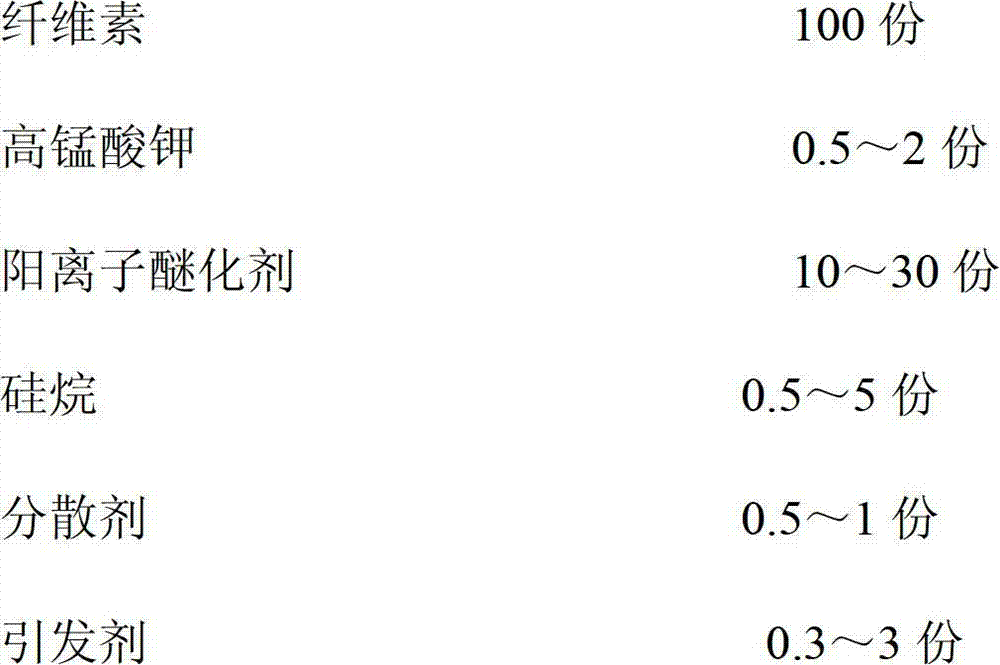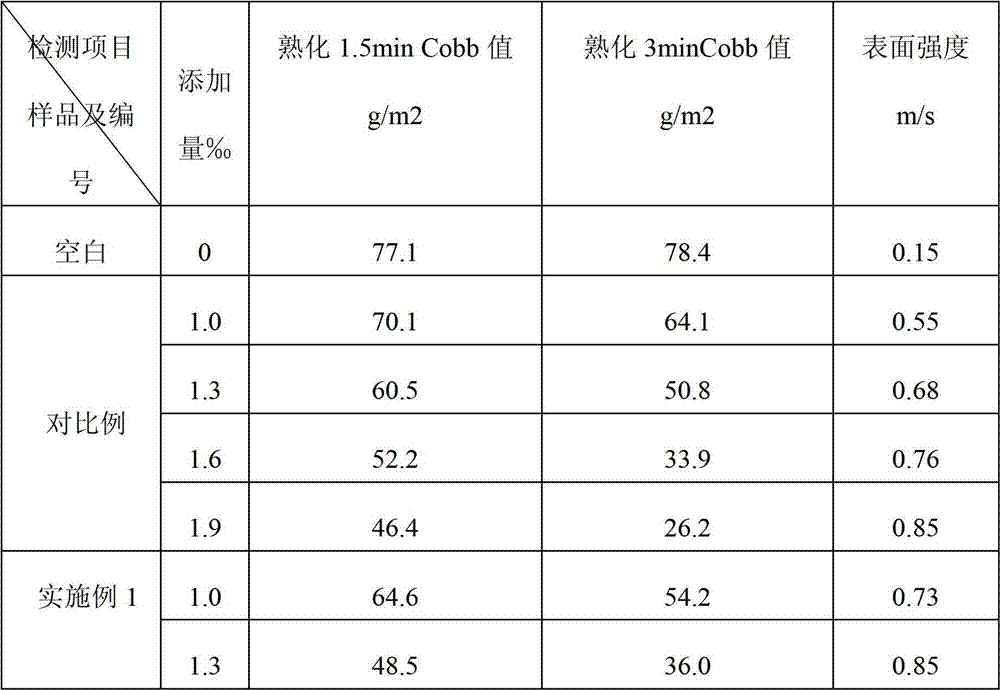Sizing agent emulsion and preparation method for same
A sizing agent and emulsion technology, applied in the direction of water repellent addition, etc., can solve problems such as low retention rate, long sizing curing time, slow fiber response, etc., to improve surface strength, reduce Cobb value, and improve hydrophobicity Effect
- Summary
- Abstract
- Description
- Claims
- Application Information
AI Technical Summary
Problems solved by technology
Method used
Image
Examples
Embodiment 1
[0030] Synthesis of cationic polymers:
[0031] a) 0.3g potassium persulfate is dissolved in 10g deionized water to be dissolved into an aqueous initiator solution, for subsequent use; 0.5g potassium permanganate is dissolved in 1.17g deionized water to be dissolved into an aqueous solution of potassium permanganate;
[0032] b) Add 100g of hydroxyethyl cellulose and 300g of deionized water into a 1000ml four-neck flask, dissolve, and heat up to 60°C;
[0033] c) At 60°C, add the potassium permanganate aqueous solution in step a) into a four-necked flask, and keep it warm at 60°C for 1 hour; use 3g of sodium hydroxide to adjust the pH to 10.31.
[0034] d) Heating up to 70°C again, quickly adding 10g of 3-chloro-2-hydroxypropyltrimethylammonium chloride into a four-neck flask, keeping it at 70°C for 2 hours; neutralizing it to pH=3.05 with 1g of sulfuric acid solution, then Add 0.5g of vinyltriisopropoxysilane and initiator solution dropwise for 5 minutes, keep warm at 70°C f...
Embodiment 2
[0040] Synthesis of cationic polymers:
[0041] a) 3g sodium persulfate is dissolved in 10g deionized water to be dissolved into initiator aqueous solution, for subsequent use; 2g potassium permanganate is dissolved in 8g deionized water to be dissolved into potassium permanganate aqueous solution;
[0042] b) Add 100g carboxymethyl cellulose and 400g deionized water into a 1000ml four-neck flask, dissolve, and heat up to 70°C;
[0043] c) At 70°C, add the potassium permanganate aqueous solution in step a) into a four-necked flask, and keep it warm at 70°C for 3 hours; use 10g of sodium hydroxide to adjust the pH to 12.85.
[0044] d) Then raise the temperature to 90°C, quickly add 30g of 2,3-epoxypropyltrimethylammonium chloride into the four-neck flask, keep it at 90°C for 5 hours; neutralize it with 3g of sulfuric acid solution to pH=4.78, then drop Add 5g of γ-methacryloyloxypropyltrimethoxysilane and initiator solution, add dropwise for 15 minutes, keep warm at 90°C for ...
Embodiment 3
[0050] Synthesis of cationic polymers:
[0051]a) 2g ammonium persulfate is dissolved in 10g deionized water to be dissolved into an aqueous initiator solution, for subsequent use; 1g potassium permanganate is dissolved in 1.5g deionized water to be dissolved into an aqueous solution of potassium permanganate;
[0052] b) Add 100g carboxymethylcellulose and 150g deionized water into a 1000ml four-neck flask, dissolve, and heat up to 65°C;
[0053] c) At 65°C, add the potassium permanganate aqueous solution in step a) into a four-necked flask, and keep it warm at 65°C for 2 hours; use 6g of sodium hydroxide to adjust the pH to 11.50.
[0054] d) Heating up to 80°C again, quickly adding 20g of 3-chloro-2-hydroxypropyltrimethylammonium chloride into a four-neck flask, keeping it at 80°C for 3 hours; neutralizing it with 2g sulfuric acid solution to pH=4.17, then Add 3g of vinyltriethoxysilane and initiator solution dropwise for 10 minutes, heat at 80°C for 0.8 hours, add 0.7g of...
PUM
| Property | Measurement | Unit |
|---|---|---|
| Viscosity | aaaaa | aaaaa |
| Viscosity | aaaaa | aaaaa |
| Viscosity | aaaaa | aaaaa |
Abstract
Description
Claims
Application Information
 Login to View More
Login to View More - R&D
- Intellectual Property
- Life Sciences
- Materials
- Tech Scout
- Unparalleled Data Quality
- Higher Quality Content
- 60% Fewer Hallucinations
Browse by: Latest US Patents, China's latest patents, Technical Efficacy Thesaurus, Application Domain, Technology Topic, Popular Technical Reports.
© 2025 PatSnap. All rights reserved.Legal|Privacy policy|Modern Slavery Act Transparency Statement|Sitemap|About US| Contact US: help@patsnap.com



